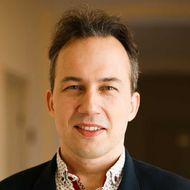Ruthenium Complexes Can Accelerate the Development of New Medicines

A group of scientists at INEOS RAS, HSE University, and MIPT have synthesised catalysts containing a ruthenium atom and an aromatic ring. The scientists have isolated the mirror forms of these catalysts and investigated their effectiveness in producing heterocycles, which are commonly found in the structures of drugs. The research findings have been published in Chemical Communications.
Isoquinoline derivatives exhibit high biological activity and are widely used as medicines such as diuretics, antibacterials, and antioxidants. One of the key stages in the synthesis of these substances is the activation of carbon-hydrogen bonds in the initial reagents. Typically, this stage must be conducted using catalysts that contain metal atoms.
Palladium compounds are most often used for such syntheses and can rightfully be considered leaders in the number of reactions they accelerate. However, they are not universally applicable. In 1993, a paper by Japanese scientists was published in Nature that described, for the first time, the carbon–hydrogen bond activation using a ruthenium catalyst. Over the last decade, the potential of these reactions has captivated scientists worldwide, with more than 300 papers published on this topic annually.
A group of Russian scientists at the A.N. Nesmeyanov Institute of Organoelement Compounds of the Russian Academy of Sciences, HSE University, and MIPT has extensive experience working with ruthenium compounds. Thus, in 2022, they obtained a ruthenium complex with an aromatic derivative of natural camphor, but it proved to be ineffective in catalysis. This year, they modified the structure of the compound to make the metal atom more accessible to reagents. A derivative of tetralin, an oil refining product, was chosen as the aromatic ring for binding ruthenium.
The resulting catalyst was separated into two enantiomers. Enantiomers are substances with the same chemical composition but different structures, similar to an object and its mirror image. The scientists used chromatography to separate the enantiomers. This process can be compared to the absorption of liquid by a sponge, where a specially selected compound acts as the sponge, absorbing the enantiomers at different rates.
'We aimed to make the synthesis as brief and straightforward as possible so that other scientists could easily use this method,' explains Dmitry Perekalin, Professor at the Joint Department of Organoelement Chemistry with the INEOS RAS, HSE Faculty of Chemistry, and Head of the Laboratory of Functional Organoelement Compounds at INEOS RAS.
The scientists used the obtained catalyst enantiomers to activate the bonds in benzamide and subsequently complete the cyclic structure of dihydroisoquinoline. The yield of the target substances was between 50% and 80%. According to the authors, the method they have developed can be used for the synthesis of other chiral catalysts, and research in this direction will continue.
The study was supported by the Russian Science Foundation, Grant 23-13-00345.
See also:
Scientists Test Asymmetry Between Matter and Antimatter
An international team, including scientists from HSE University, has collected and analysed data from dozens of experiments on charm mixing—the process in which an unstable charm meson oscillates between its particle and antiparticle states. These oscillations were observed only four times per thousand decays, fully consistent with the predictions of the Standard Model. This indicates that no signs of new physics have yet been detected in these processes, and if unknown particles do exist, they are likely too heavy to be observed with current equipment. The paper has been published in Physical Review D.
HSE Scientists Reveal What Drives Public Trust in Science
Researchers at HSE ISSEK have analysed the level of trust in scientific knowledge in Russian society and the factors shaping attitudes and perceptions. It was found that trust in science depends more on everyday experience, social expectations, and the perceived promises of science than on objective knowledge. The article has been published in Universe of Russia.
Scientists Uncover Why Consumers Are Reluctant to Pay for Sugar-Free Products
Researchers at the HSE Institute for Cognitive Neuroscience have investigated how 'sugar-free' labelling affects consumers’ willingness to pay for such products. It was found that the label has little impact on the products’ appeal due to a trade-off between sweetness and healthiness: on the one hand, the label can deter consumers by implying an inferior taste, while on the other, it signals potential health benefits. The study findings have been published in Frontiers in Nutrition.
HSE Psycholinguists Launch Digital Tool to Spot Dyslexia in Children
Specialists from HSE University's Centre for Language and Brain have introduced LexiMetr, a new digital tool for diagnosing dyslexia in primary school students. This is the first standardised application in Russia that enables fast and reliable assessment of children’s reading skills to identify dyslexia or the risk of developing it. The application is available on the RuStore platform and runs on Android tablets.
Physicists Propose New Mechanism to Enhance Superconductivity with 'Quantum Glue'
A team of researchers, including scientists from HSE MIEM, has demonstrated that defects in a material can enhance, rather than hinder, superconductivity. This occurs through interaction between defective and cleaner regions, which creates a 'quantum glue'—a uniform component that binds distinct superconducting regions into a single network. Calculations confirm that this mechanism could aid in developing superconductors that operate at higher temperatures. The study has been published in Communications Physics.
Neural Network Trained to Predict Crises in Russian Stock Market
Economists from HSE University have developed a neural network model that can predict the onset of a short-term stock market crisis with over 83% accuracy, one day in advance. The model performs well even on complex, imbalanced data and incorporates not only economic indicators but also investor sentiment. The paper by Tamara Teplova, Maksim Fayzulin, and Aleksei Kurkin from the Centre for Financial Research and Data Analytics at the HSE Faculty of Economic Sciences has been published in Socio-Economic Planning Sciences.
Larger Groups of Students Use AI More Effectively in Learning
Researchers at the Institute of Education and the Faculty of Economic Sciences at HSE University have studied what factors determine the success of student group projects when they are completed with the help of artificial intelligence (AI). Their findings suggest that, in addition to the knowledge level of the team members, the size of the group also plays a significant role—the larger it is, the more efficient the process becomes. The study was published in Innovations in Education and Teaching International.
New Models for Studying Diseases: From Petri Dishes to Organs-on-a-Chip
Biologists from HSE University, in collaboration with researchers from the Kulakov National Medical Research Centre for Obstetrics, Gynecology, and Perinatology, have used advanced microfluidic technologies to study preeclampsia—one of the most dangerous pregnancy complications, posing serious risks to the life and health of both mother and child. In a paper published in BioChip Journal, the researchers review modern cellular models—including advanced placenta-on-a-chip technologies—that offer deeper insights into the mechanisms of the disorder and support the development of effective treatments.
Using Two Cryptocurrencies Enhances Volatility Forecasting
Researchers from the HSE Faculty of Economic Sciences have found that Bitcoin price volatility can be effectively predicted using Ethereum, the second-most popular cryptocurrency. Incorporating Ethereum into a predictive model reduces the forecast error to 23%, outperforming neural networks and other complex algorithms. The article has been published in Applied Econometrics.
Administrative Staff Are Crucial to University Efficiency—But Only in Teaching-Oriented Institutions
An international team of researchers, including scholars from HSE University, has analysed how the number of non-academic staff affects a university’s performance. The study found that the outcome depends on the institution’s profile: in research universities, the share of administrative and support staff has no effect on efficiency, whereas in teaching-oriented universities, there is a positive correlation. The findings have been published in Applied Economics.



